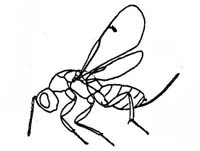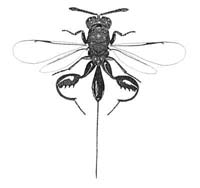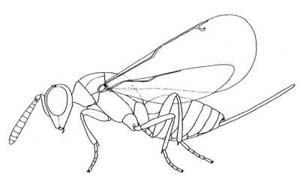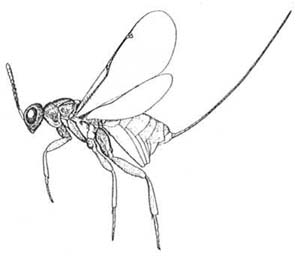Universal Chalcidoidea Database
Notes on families
Torymidae
Main diagnostic characters
1. Female with ovipositor clearly exserted, sometimes much longer than abdomen (100%)
2. Stigmal vein very short (although sometimes with stigma very enlarged) so that apex of uncus almost touches anterior margin of forewing (100%)
3. Petiole strongly transverse, not distinct (99%)
4. Body generally elongate, excluding ovipositor about 1.1-7.5mm in length, including ovipositor up to 16.0mm in length (100%)
5. Cercal plates not flat, slightly raised and papillar in form
(99%)
Included taxa
The family currently includes 68 genera and 986 species placed in 2 subfamilies as follows: Megastigminae (12/174), Toryminae (55/808), unplaced (1/4, fossil).
 |
 |
| Megastigminae (Megastigmus sp.) |
Toryminae (Podagrion sp.) |
Biology
Many British torymids oviposit through plant tissue, usually into galls or developing seeds, but some oviposit into pupae concealed in silk or plant tissue. Torymid larvae may be entomophagous or, less commonly, phytophagous; some may even be both, feeding in turn on gall maker and gall tissue as in some Eurytomidae.
The majority of species of the subfamily Toryminae, many Monodontomerinae and a few species of Megastigminae are idiobiont ectoparasitoids of the inhabitants of plant galls. For example, Torymus erucarum, Megastigmus dorsalis and M. stigmatizans attack insect larvae found in cynipid galls on oaks (Askew, 1965; 1966), Glyphomerus stigma is a parasitoid in Diplolepis galls on rose, and some North American species of the genera Pseudotorymus and Cryptopristus parasitize gall-forming eurytomids and cecidomyiids (Peck et al., 1964; Grissell, 1979). However, several species of Torymus that oviposit into cynipid galls do not develop as parasitoids. They are inquilines and develop on the gall tissue, either after having destroyed the cynipid (eg T. auratus), or alongside the cynipid larvae which is destroyed later (eg T. cyaneus) (Askew, 1961a; 1965b).
 |
| Toryminae (Torymoides sp.) |
Not all parasitic torymids attack the inhabitants of galls. One species of Torymus has been observed to be a hyperparasitoid developing ectophagously on a pteromalid parasitoid of beetle larvae in Sarothamnus seed-pods (Parnell, 1964). This torymid was never found as a primary parasitoid of the beetle larva. Several torymids are associated with aculeate Hymenoptera. For example, one British species of Torymus, T. armatus, is a parasitoid of stem-nesting sphecids, especially species of Rhopalum (Danks, 1971). The torymid oviposits through the plant-stem wall on to the aculeate prepupa in its cocoon. Another British species, Monodontomerus obscurus, is an ectoparasitoid of various solitary bees, especially megachilines of the genera Osmia and Megachile (Eves, 1970).
One of the most complex of torymid life-histories is that of Monodontomerus aereus. This species is a gregarious internal parasitoid of various lymantriid pupae, but it may also develop as a hyperparasitoid. In such a case it feeds externally on the ichneumonoid or tachinid primary parasitoid, unless the tachinid puparium happens to be very fresh and then it will develop endophagously (Muesebeck, 1931). Various other species of Monodontomerus are known to parasitize diprionids, heterarthrine tenthredinids and sphecids, and species in related but non-British genera attack scolytid, bruchid and curculionid beetles (Clausen, 1956; Grissell, 1979).
 |
| Toryminae (Torymus varians) |
A number of torymids are specialist phytophages that feed on the highly nutritious endosperm in developing seeds (Hussey, 1955). The majority of such species belong to the genus Megastigmus. They develop in seeds of various Cupressaceae, Pinaceae and arborescent Rosaceae. Those species studied have similar biologies; the female oviposits in early summer into the developing seeds in the young cones or fruits and the solitary larvae feed all summer, consuming virtually the entire contents of the seed. They overwinter as prepupae in the seed, before generally pupating the following spring (Hussey, 1955; Skrzypczynska, 1978). Some individuals of certain species may diapause for two or three years. The adult Megastigmus emerges through a small circular hole. Most species are restricted to a single plant genus. For example, Megastigmus aculeatus develops in seeds of roses, M. bipunctatus attacks those of juniper and M. spermatrophus feeds on Douglas Fir (Pseudotsuga). This latter species occasionally assumes the status of a minor pest in Scotland where it has been found to damage seed stocks (Chrystal, 1937). Megastigmus suspectus is a pest of Abies alba in Europe (Skrzypczynska, 1978). Amongst the Toryminae Torymus (Syntomaspis) species are known to feed in seeds of various arborescent Rosaceae such as Sorbus, Pyrus, Malus and Crataegus.
Species of the non-British tribe Podagrionini (Toryminae) are parasitoids of the eggs of Mantidae. Sometimes females are phoretic on the adult female mantid, thus ensuring that they have access to freshly deposited eggs which they must reach before the froth of the ootheca hardens (Bordage, 1913).
Torymids lay kidney-shaped to very elongate ovoid eggs in, on, or near to the food source (Askew, 1966; Skrzypzynska, 1978). The eggs of Monodontomerus bear numerous minute recurved spines (Muesebeck, 1931). The larvae are hymenopteriform, and their cuticle bears setae; these setae are most conspicuous in parasitic species (Varley, 1937; Danks, 1971; Askew & Ruse 1974), but are inconspicuous in phytophagous species (Hussey, 1955; Askew, 1966). Overwintering is generally as a fully fed larva, and pupation generally occurs the following year. The female pupa has the ovipositor externally visible and bent over its dorsum (Skrzypzynska, 1978).
Identification
Hoffmeyer, 1930-31 (genera and species in Denmark); Peck, Boucek & Hoffer, 1964 (Central European genera); Boucek, 1988 (Australasian genera); Askew, 1961b (species associated with oak galls); Graham & Gijswijt (1998) (European species of Torymus); Grissell, 1995 (World genera); Narendran, 1994 (Indian genera and species).
References
Askew, R.R. 1961a. Eupelmus urozonus Dalman (Hym. Chalcidoidea) as a parasite in cynipid oak galls. Entomologist 94:196-201.
Askew, R.R. 1961b. On the biology of the inhabitants of oak galls of Cynipidae (Hym.) in Britain. Transactions of the Society for British Entomology 14(11):237-268.
Askew, R.R. 1965. The biology of the British species of the genus Torymus Dalman associated with galls of Cynipidae on oak, with special reference to alternation of forms. Transactions of the Society for British Entomology 16:217-232.
Askew, R.R. 1966. Observations on the British species of Megastigmus Dalman (Hym. Torymidae) which inhabit cynipid oak galls. Entomologist 99:124-128.
Askew, R.R.; Ruse, M. 1974. The biology of some Cecidomyiidae (Diptera) galling the leaves of birch (Betula) with special reference to their chalcidoid (Hymenoptera) parasites. Transactions of the Royal Entomological Society of London 126(2):129-167.
Bordage, E. 1913. Notes biologiques reçueilles . l'Ile de la Réunion. Bull. Scient. de la Fr. et Belg. 47(4):377-412.
Boucek, Z. 1988. Australasian Chalcidoidea (Hymenoptera). A biosystematic revision of genera of fourteen families, with a reclassification of species. :832pp.. CAB International, Wallingford, Oxon, U.K., Cambrian News Ltd; Aberystwyth, Wales.
Chrystal, R.N. 1937. Insects of British Woodlands :338pp. Frederick Warne & Co., London and New York .
Clausen, C.P. 1956. Biological control of insect pests in the continental United States. Technical Bulletin United States Department of Agriculture 1139:151pp.
Danks, H.V. 1971. Biology of some stem-nesting aculeate Hymenoptera. Transactions of the Royal Entomological Society of London 122:323-395.
Eves, J.D. 1970. Biology of Monodontomerus obscurus Westw., a parasite of the alfalfa leafcutting bee, Megachile rotundata (Fabricius). Melanderia 4:1-18.
Graham, M.W.R. de V. & Gijswijt, M.J. 1998. Revision of the European species of Torymus Dalman (s. lat.) (Hmyenoptera: Troymidae). Zoologische Verhandelingen 317:1-202.
Grissell, E.E. 1979. Family Torymidae. Catalogue of Hymenoptera in America North of Mexico 1:748-769. (Ed.: Krombein, K.V.; Hurd, P.D.; Smith, D.R.; Burks, B.D.) Smithsonian Institution Press, Washington, D.C.
Grissell, E.E. 1995. Toryminae (Hymenoptera: Chalcidoidea: Torymidae): a redefinition, generic classification and annotated world catalogue of species. Memoirs on Entomology, International 2:474pp.
Hoffmeyer, E.B. 1930. Beiträge zur Kenntnis der dänischen Callimomiden, mit Bestimmungsrabellen der europäischen Arten. (Hym. Chalc.) (Slutning) Entomologiske Meddelelser 17:232-260.
Hoffmeyer, E.B. 1931. Beiträge zur Kenntnis der dänischen callimomiden, mit Bestimmungstabellen der europäischen Arten. (Hym., Chalc.) (Callimomidenstudien 5.). Entomologiske Meddelelser 17:261-285.
Hussey, N.W. 1955. The life-histories of Megastigmus spermatrophus Wachtl (Hymenoptera: Chalcidoidea) and its principal parasites with descriptions of the developmental stages. Transactions of the Royal Entomological Society of London 106:133-151.
Muesebeck, C.F.W. 1931. Monodontomerus aereus Walker, both a primary and a secondary parasite of the brown-tail moth and the gypsy moth. Journal of Agricultural Research 43(5):445-459.
Narendran, T.C. 1994. Torymidae and Eurytomidae of Indian subcontinent. 500pp. University of Calicut, Kerala, India.
Parnell, J.R. 1964. The parasite complex of two seed beetles Bruchidius ater Marsh (Col., Bruchidae) and Apion fuscirostre Fbr. (Col., Curculionidae). Transactions of the Royal Entomological Society of London 116:73-88.
Peck, O.; Boucek, Z.; Hoffer, A. 1964. Keys to the Chalcidoidea of Czechoslovakia (Insecta: Hymenoptera). Memoirs of the Entomological Society of Canada No 34:170pp, 289 figs.
Skrzypczynska, M. 1978. Megastigmus suspectus Borries, 1895 (Hymenoptera, Torymidae), its morphology, biology and economic significance. Zeitschrift für Angewandte Entomologie 85:204-215.
Varley, G.C. 1937. Description of the eggs and larvae of four species of chalcidoid Hymenoptera parasitic on the knapweed gall-fly. Proceedings of the Royal Entomological Society of London (B) 6:122-130, 5 figs.
Previous page | Next pageLast updated 07-Jun-2004 Dr B R Pitkin